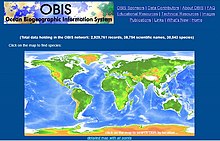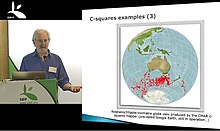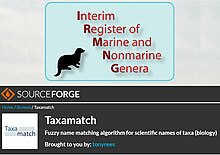Genus is a taxonomic rank used in the biological classification of living and fossil organisms as well as viruses. In the hierarchy of biological classification, genus comes above species and below family. In binomial nomenclature, the genus name forms the first part of the binomial species name for each species within the genus.
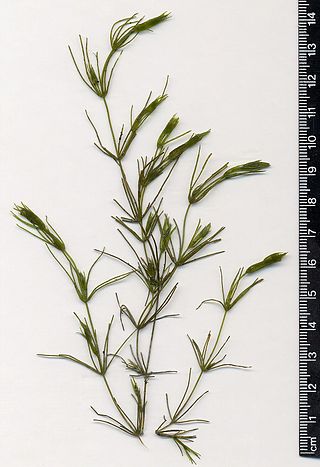
Charales is an order of freshwater green algae in the division Charophyta, class Charophyceae, commonly known as stoneworts. Depending on the treatment of the genus Nitellopsis, living (extant) species are placed into either one family (Characeae) or two. Further families are used for fossil members of the order. Linnaeus established the genus Chara in 1753.

The Integrated Taxonomic Information System (ITIS) is an American partnership of federal agencies designed to provide consistent and reliable information on the taxonomy of biological species. ITIS was originally formed in 1996 as an interagency group within the US federal government, involving several US federal agencies, and has now become an international body, with Canadian and Mexican government agencies participating. The database draws from a large community of taxonomic experts. Primary content staff are housed at the Smithsonian National Museum of Natural History and IT services are provided by a US Geological Survey facility in Denver. The primary focus of ITIS is North American species, but many biological groups exist worldwide and ITIS collaborates with other agencies to increase its global coverage.
Biodiversity informatics is the application of informatics techniques to biodiversity information, such as taxonomy, biogeography or ecology. It is defined as the application of Information technology technologies to management, algorithmic exploration, analysis and interpretation of primary data regarding life, particularly at the species level organization. Modern computer techniques can yield new ways to view and analyze existing information, as well as predict future situations. Biodiversity informatics is a term that was only coined around 1992 but with rapidly increasing data sets has become useful in numerous studies and applications, such as the construction of taxonomic databases or geographic information systems. Biodiversity informatics contrasts with "bioinformatics", which is often used synonymously with the computerized handling of data in the specialized area of molecular biology.
Leptomitales are an order of water moulds within the class Oomycetes that contains the genus Apodachlya.
C-squares is a system of spatially unique, location-based identifiers (geocodes) for areas on the surface of the earth, represented as cells from a latitude- and longitude-based Discrete Global Grid at a hierarchical set of resolution steps, obtained by progressively subdividing 10×10 degree World Meteorological Organization squares; the term "c-square" is also available for use to designate any component cell of the grid. Individual cell identifiers incorporate literal values of latitude and longitude in an interleaved notation, together with additional digits that support intermediate grid resolutions of 5, 0.5, 0.05 degrees, etc.
The World Register of Marine Species (WoRMS) is a taxonomic database that aims to provide an authoritative and comprehensive list of names of marine organisms.
Darwin Core is an extension of Dublin Core for biodiversity informatics. It is meant to provide a stable standard reference for sharing information on biological diversity (biodiversity). The terms described in this standard are a part of a larger set of vocabularies and technical specifications under development and maintained by Biodiversity Information Standards (TDWG).
Parechelus is an extinct genus of prehistoric bony fish that lived during the Ypresian. The genus was circumscribed by Edgard Casier in 1967 for his description of P. parechelus.
A taxonomic database is a database created to hold information on biological taxa – for example groups of organisms organized by species name or other taxonomic identifier – for efficient data management and information retrieval. Taxonomic databases are routinely used for the automated construction of biological checklists such as floras and faunas, both for print publication and online; to underpin the operation of web-based species information systems; as a part of biological collection management ; as well as providing, in some cases, the taxon management component of broader science or biology information systems. They are also a fundamental contribution to the discipline of biodiversity informatics.

AquaMaps is a collaborative project with the aim of producing computer-generated predicted global distribution maps for marine species on a 0.5 x 0.5 degree grid of the oceans based on data available through online species databases such as FishBase and SeaLifeBase and species occurrence records from OBIS or GBIF and using an environmental envelope model in conjunction with expert input. The underlying model represents a modified version of the relative environmental suitability (RES) model developed by Kristin Kaschner to generate global predictions of marine mammal occurrences.
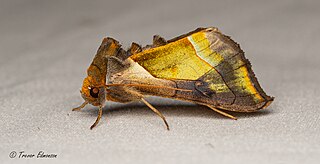
Diachrysia balluca, commonly known as the green-patched looper or hologram moth, is a moth of the family Noctuidae. The species was first described by scientific illustrator Carl Geyer in 1832.
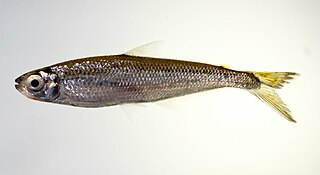
Iguanodectes is a genus of freshwater fish found in tropical South America, with eight currently described species. They are all small tetras, none longer than 5 inches, and often have attractive silvery or striped scales, which makes them a target for the ornamental fish industry. Alongside the genus Piabucus, it is in the subfamily Iguanodectinae, which in turn is in the family Iguanodectidae. The genus Bryconops, which is also in Iguanodectidae, makes up a sister clade to Iguanodectinae.

The Flanders Marine Institute provides a focal point for marine scientific research in Flanders, northern Belgium.

The Interim Register of Marine and Nonmarine Genera (IRMNG) is a taxonomic database which attempts to cover published genus names for all domains of life from 1758 in zoology up to the present, arranged in a single, internally consistent taxonomic hierarchy, for the benefit of Biodiversity Informatics initiatives plus general users of biodiversity (taxonomic) information. In addition to containing over 490,000 published genus name instances as at March 2020, the database holds over 1.7 million species names, although this component of the data is not maintained in as current or complete state as the genus-level holdings. IRMNG can be queried online for access to the latest version of the dataset and is also made available as periodic snapshots or data dumps for import/upload into other systems as desired.

× Oncostele, abbreviated Ons., is a hybrid genus of orchids, used for greges containing at least one ancestor species from the genera Oncidium (Onc.) and Rhynchostele (Rst.). The nothogenus was defined in 2003 by J. M. H. Shaw.

Nomenclator Zoologicus is one of the major compendia in the field of zoological nomenclature, compiled by Sheffield Airey Neave and his successors and published in 9 volumes over the period 1939–1994, under the auspices of the Zoological Society of London; a tenth, electronic-only volume was also produced before the project ceased. It contains over 340,000 published name instances with their authorities and details of their original publication, certain nomenclatural notes and cross references, and an indication of the taxonomic group to which each is assigned. An electronic (digitised) version of volumes 1-10 was released online by the uBio project, based at the Marine Biological Laboratory, Woods Hole, in 2004–2005.

The Ocean Biodiversity Information System (OBIS), formerly Ocean Biogeographic Information System, is a web-based access point to information about the distribution and abundance of living species in the ocean. It was developed as the information management component of the ten year Census of Marine Life (CoML) (2001-2010), but is not limited to CoML-derived data, and aims to provide an integrated view of all marine biodiversity data that may be made available to it on an open access basis by respective data custodians. According to its web site as at July 2018, OBIS "is a global open-access data and information clearing-house on marine biodiversity for science, conservation and sustainable development." 8 specific objectives are listed in the OBIS site, of which the leading item is to "Provide [the] world's largest scientific knowledge base on the diversity, distribution and abundance of all marine organisms in an integrated and standardized format".
Compsosaurus is an extinct genus of phytosaur, a crocodile-like reptile that lived during the Triassic. Its fossils have been found in North Carolina. The type species, Compsosaurus priscus, was named by American paleontologist Joseph Leidy in 1856, although other sources say 1857. Compsosaurus may have been the same animal as the related Belodon.

Laxta friedmani, the flat cockroach, is a species of Blaberidae occurring in Australia. The habitat is under loose back of eucalyptus trees, and fallen leaf litter on the ground. Length is up to 25 mm, a flattened creature, resembling a trilobite, sometimes found in small groups. Females are wingless, adult males with wings.

